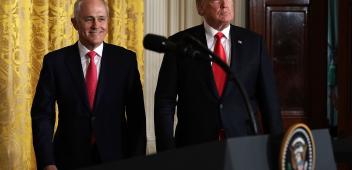How we got tangled up in US dollar politics
This piece was originally published in the Australian Financial Review

Executive Summary
Last month The Australian Financial Review reported remarks by US policymakers who had "expressed concern" over Australian "authorities' public statements on the desired direction of the exchange rate".
It's pretty clear that US sights were set on the mandarins at the Reserve Bank of Australia, who regularly comment on the value of the Aussie dollar. Glenn Stevens, governor of the RBA, retorted that the central bank's statements were "absolutely" consistent with Australia's free-floating currency.
The initial shot had come from the United States executive director to the board of the IMF. It was fired in the context of Australia's Article 4 consultation, the regular economic health check the IMF administers to its members, in September.
It's unlikely the US executive director found many friends around the executive board table. The board delivers an assessment at the end of its discussion on the consultation. There is no trace of any dissatisfaction in that document. Indeed, the assessment praised Australia's flexible exchange rate regime. So what is this about?
It is hard to know. Perhaps it's all just part of the US exchange rate policy muddle.
We have seen this confusion in action during the presidential primaries. Donald Trump has called for a 45 per cent tariff to be placed on Chinese goods in response to China's weak exchange rate. The problem with this line of logic, of course, is that the Chinese authorities for the last few months have been intervening to keep the value of the yuan up. And they have burnt through considerable reserves to do so.
If the Chinese were to just let the market determine the value of the yuan, then its value would likely fall. Hardly the outcome Trump, and many other US commentators, would be aiming for. In any case, the IMF has said that the yuan is fairly valued. The big bogeyman of a Chinese undervalued exchange rate simply does not exist.
This bogeyman prompted a call by US politicians for the inclusion of a currency manipulation chapter in the recently concluded Trans-Pacific Partnership (TPP). The idea was that currency manipulation should be eliminated by TPP signatories. In 2013, 60 US senators sent a letter to the secretary of the Treasury and United States trade representative calling for "strong and enforceable foreign currency manipulation disciplines" in the TPP; 230 members of Congress sent a letter to President Barack Obama raising similar issues.
While currency manipulation isn't in the TPP itself, there is some discussion of it in a side agreement. The signatories of that agreement have committed to more transparency, but it is all rather toothless.
Why is currency politics so sensitive in the US? It could be the role the US dollar plays as the international reserve currency, but that is often wrapped up in rhetoric about the need for a "strong" dollar. The US, in that case, should be comfortable with weaker currencies in other countries.
Perhaps it has to do with Washington's muddled policy framework. In the US, responsibility for dollar policy lies in with the US Treasury. However the Federal Reserve is the agency with the most potent influence on the value of the dollar, through monetary policy. So those espousing dollar policy are not those with the strongest means to affect it. That can lead to a climate of confusion, where even free-floaters like Australia come in for criticism.
Leon Berkelmans is international economy program director at the Lowy Institute.



